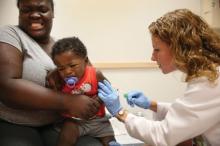User login
As the recent measles outbreak spreads out from its apparent epicenter at Disneyland Resorts in California, the media spotlights have again swung to the problem of underimmunization and the effect of vaccine refusal by parents. Because the statistics that are so alarming to us as pediatricians have little audience-grabbing appeal for print and electronic journalists, nearly every story about immunizations includes a picture of a young child screaming in pain and/or horror as he or she is receiving or is about to receive an injection.
In the Wall Street Journal, I was assaulted by one of the more egregious examples of this kind of inflammatory and fear-mongering photojournalism. The four-column-wide image depicts a cute 10- to 12-month old boy sitting in his mother’s lap encircled by her ample arms. He is grimacing, eyes puffed from crying as he is receives an injection in his left upper arm. You know he is about to shriek and the pacifier will fall out of his mouth. His mother is also grimacing, her teeth bared. Her eyes are clenched closed as she turns away from the horror.
The villain in this scene could be the young woman clothed in a lab coat and wearing blue plastic gloves. Of course, it isn’t much of a leap to believe that the real villain is the syringe and the vaccine it contains. A closer look at the image reveals the thumb of a gloved hand that is holding the little victim’s left leg. His puffy eyes suggest that this moment is the culmination of a long and unpleasant preamble.
Of course, the first and most important question we must ask is why does the media persist in using these anxiety-provoking images to embellish otherwise evenhanded and well-written stories about vaccine refusal? You might defend the journalists by pointing out that kids often cry when they get shots and that it is hard to find images of a contented child receiving an injection. Baloney!
I have just done a quick Google image search of “children receiving immunizations,” and what I found in scrolling down the first 45 photos of children receiving injections was that only five were crying – seven, in fact, were smiling! The rest had neutral facial expressions and body postures.
I saw a picture of the same white-coated injector in the New York Times. This time, the victim was girl about age 2 years, in full scream, sitting on her mother’s lap, her right arm pinned by her mother and an ungloved fully visible pink-printed grandmotherly assistant. The injector’s face revealed more than a trace of anxiety. Both these images were attributed to Getty Images and were probably from the same photo shoot. Obviously, the editors responsible for these stories hadn’t looked very hard for a photograph that might portray immunizations in a more-positive light.
Much has been written lately about religious and antiscience (or at least junk science) aspects of vaccine refusal. I don’t recall seeing much, if anything, said about just plain old needle fear. I suspect that many vaccine decliners are hiding (consciously or unconsciously) their fear of injections under the cloak of “intellectual” or religious choice. By continuing to use the kinds of fear-mongering images I have described, journalists are fueling the vaccine refusal debate.
How about you and I who provide immunizations on a regular basis adopt a policy of refusing to allow pictures from our offices to be taken immunizing uncooperative or terrified children? Or at least journalists should be forced publish three images of contented vaccine recipients for every photograph of a screaming child. Or, even better, how about a one-for-one arrangement that shows one child in the intensive care unit as the result of a vaccine-preventable illness for every crying injection recipient?
Dr. Wilkoff practiced primary care pediatrics in Brunswick, Maine, for nearly 40 years. He has authored several books on behavioral pediatrics, including “How to Say No to Your Toddler.” E-mail him at [email protected].
As the recent measles outbreak spreads out from its apparent epicenter at Disneyland Resorts in California, the media spotlights have again swung to the problem of underimmunization and the effect of vaccine refusal by parents. Because the statistics that are so alarming to us as pediatricians have little audience-grabbing appeal for print and electronic journalists, nearly every story about immunizations includes a picture of a young child screaming in pain and/or horror as he or she is receiving or is about to receive an injection.
In the Wall Street Journal, I was assaulted by one of the more egregious examples of this kind of inflammatory and fear-mongering photojournalism. The four-column-wide image depicts a cute 10- to 12-month old boy sitting in his mother’s lap encircled by her ample arms. He is grimacing, eyes puffed from crying as he is receives an injection in his left upper arm. You know he is about to shriek and the pacifier will fall out of his mouth. His mother is also grimacing, her teeth bared. Her eyes are clenched closed as she turns away from the horror.
The villain in this scene could be the young woman clothed in a lab coat and wearing blue plastic gloves. Of course, it isn’t much of a leap to believe that the real villain is the syringe and the vaccine it contains. A closer look at the image reveals the thumb of a gloved hand that is holding the little victim’s left leg. His puffy eyes suggest that this moment is the culmination of a long and unpleasant preamble.
Of course, the first and most important question we must ask is why does the media persist in using these anxiety-provoking images to embellish otherwise evenhanded and well-written stories about vaccine refusal? You might defend the journalists by pointing out that kids often cry when they get shots and that it is hard to find images of a contented child receiving an injection. Baloney!
I have just done a quick Google image search of “children receiving immunizations,” and what I found in scrolling down the first 45 photos of children receiving injections was that only five were crying – seven, in fact, were smiling! The rest had neutral facial expressions and body postures.
I saw a picture of the same white-coated injector in the New York Times. This time, the victim was girl about age 2 years, in full scream, sitting on her mother’s lap, her right arm pinned by her mother and an ungloved fully visible pink-printed grandmotherly assistant. The injector’s face revealed more than a trace of anxiety. Both these images were attributed to Getty Images and were probably from the same photo shoot. Obviously, the editors responsible for these stories hadn’t looked very hard for a photograph that might portray immunizations in a more-positive light.
Much has been written lately about religious and antiscience (or at least junk science) aspects of vaccine refusal. I don’t recall seeing much, if anything, said about just plain old needle fear. I suspect that many vaccine decliners are hiding (consciously or unconsciously) their fear of injections under the cloak of “intellectual” or religious choice. By continuing to use the kinds of fear-mongering images I have described, journalists are fueling the vaccine refusal debate.
How about you and I who provide immunizations on a regular basis adopt a policy of refusing to allow pictures from our offices to be taken immunizing uncooperative or terrified children? Or at least journalists should be forced publish three images of contented vaccine recipients for every photograph of a screaming child. Or, even better, how about a one-for-one arrangement that shows one child in the intensive care unit as the result of a vaccine-preventable illness for every crying injection recipient?
Dr. Wilkoff practiced primary care pediatrics in Brunswick, Maine, for nearly 40 years. He has authored several books on behavioral pediatrics, including “How to Say No to Your Toddler.” E-mail him at [email protected].
As the recent measles outbreak spreads out from its apparent epicenter at Disneyland Resorts in California, the media spotlights have again swung to the problem of underimmunization and the effect of vaccine refusal by parents. Because the statistics that are so alarming to us as pediatricians have little audience-grabbing appeal for print and electronic journalists, nearly every story about immunizations includes a picture of a young child screaming in pain and/or horror as he or she is receiving or is about to receive an injection.
In the Wall Street Journal, I was assaulted by one of the more egregious examples of this kind of inflammatory and fear-mongering photojournalism. The four-column-wide image depicts a cute 10- to 12-month old boy sitting in his mother’s lap encircled by her ample arms. He is grimacing, eyes puffed from crying as he is receives an injection in his left upper arm. You know he is about to shriek and the pacifier will fall out of his mouth. His mother is also grimacing, her teeth bared. Her eyes are clenched closed as she turns away from the horror.
The villain in this scene could be the young woman clothed in a lab coat and wearing blue plastic gloves. Of course, it isn’t much of a leap to believe that the real villain is the syringe and the vaccine it contains. A closer look at the image reveals the thumb of a gloved hand that is holding the little victim’s left leg. His puffy eyes suggest that this moment is the culmination of a long and unpleasant preamble.
Of course, the first and most important question we must ask is why does the media persist in using these anxiety-provoking images to embellish otherwise evenhanded and well-written stories about vaccine refusal? You might defend the journalists by pointing out that kids often cry when they get shots and that it is hard to find images of a contented child receiving an injection. Baloney!
I have just done a quick Google image search of “children receiving immunizations,” and what I found in scrolling down the first 45 photos of children receiving injections was that only five were crying – seven, in fact, were smiling! The rest had neutral facial expressions and body postures.
I saw a picture of the same white-coated injector in the New York Times. This time, the victim was girl about age 2 years, in full scream, sitting on her mother’s lap, her right arm pinned by her mother and an ungloved fully visible pink-printed grandmotherly assistant. The injector’s face revealed more than a trace of anxiety. Both these images were attributed to Getty Images and were probably from the same photo shoot. Obviously, the editors responsible for these stories hadn’t looked very hard for a photograph that might portray immunizations in a more-positive light.
Much has been written lately about religious and antiscience (or at least junk science) aspects of vaccine refusal. I don’t recall seeing much, if anything, said about just plain old needle fear. I suspect that many vaccine decliners are hiding (consciously or unconsciously) their fear of injections under the cloak of “intellectual” or religious choice. By continuing to use the kinds of fear-mongering images I have described, journalists are fueling the vaccine refusal debate.
How about you and I who provide immunizations on a regular basis adopt a policy of refusing to allow pictures from our offices to be taken immunizing uncooperative or terrified children? Or at least journalists should be forced publish three images of contented vaccine recipients for every photograph of a screaming child. Or, even better, how about a one-for-one arrangement that shows one child in the intensive care unit as the result of a vaccine-preventable illness for every crying injection recipient?
Dr. Wilkoff practiced primary care pediatrics in Brunswick, Maine, for nearly 40 years. He has authored several books on behavioral pediatrics, including “How to Say No to Your Toddler.” E-mail him at [email protected].


